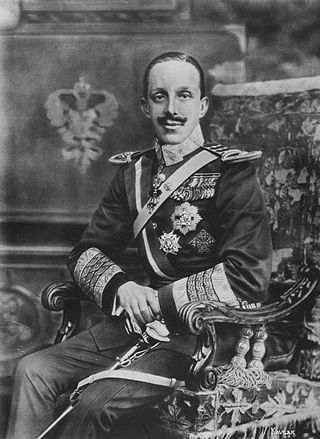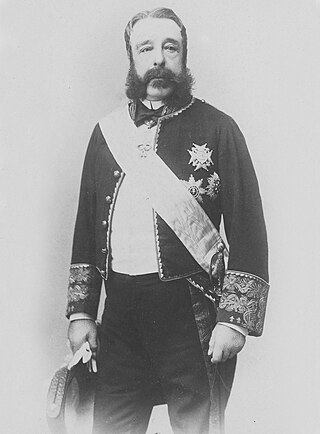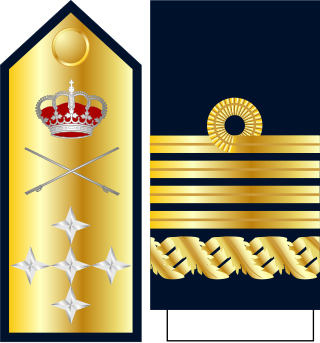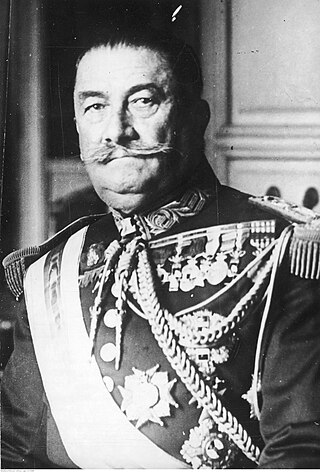This article needs additional citations for verification .(June 2018) |
| |||||
| Decades: | |||||
|---|---|---|---|---|---|
| See also: | Other events of 1941 List of years in Spain | ||||
Events in the year 1941 in Spain .
This article needs additional citations for verification .(June 2018) |
| |||||
| Decades: | |||||
|---|---|---|---|---|---|
| See also: | Other events of 1941 List of years in Spain | ||||
Events in the year 1941 in Spain .

Alfonso XII, also known as El Pacificador, was King of Spain from 29 December 1874 to his death in 1885.

Alfonso XIII, also known as El Africano or the African for his Africanist views, was King of Spain from his birth until 14 April 1931, when the Second Spanish Republic was proclaimed. He became a monarch at birth as his father, Alfonso XII, had died the previous year. Alfonso's mother, Maria Christina of Austria, served as regent until he assumed full powers on his sixteenth birthday in 1902.

Alfonso, Duke of Anjou, Duke of Cádiz, Grandee of Spain was a grandson of King Alfonso XIII of Spain, a potential heir to the throne in the event of the restoration of the Spanish monarchy, and the Legitimist claimant to the throne of France.

Infante Jaime of Spain, Duke of Segovia was the second son of Alfonso XIII, King of Spain and his wife Princess Victoria Eugenie of Battenberg. He was born in the Royal Palace of La Granja de San Ildefonso in Province of Segovia, and was consequently granted the non-substantive title of "Duke of Segovia". Upon his father's death in 1941, Jaime inherited the Legitimist claim to the French throne and thereafter used the courtesy title "Duke of Anjou".

Infante Alfonso of Spain was the younger brother of King Juan Carlos I of Spain. He was also the youngest son of Infante Juan, Count of Barcelona and Princess María de las Mercedes of Bourbon-Two Sicilies, and the grandson of King Alfonso XIII. He died young at 14 from a shot by Juan Carlos' gun, but the circumstances of his death remain unclear to this day.

Alfonso de Orleans y Borbón, Infante of Spain, Duke of Galliera, was a Spanish prince, military aviator and first cousin of Alfonso XIII of Spain.

DonGonzalo, Duke of Aquitaine was a grandson of Alfonso XIII, King of Spain.

DonCristóbal Martínez-Bordiú y Ortega, 10th Marquess of Villaverde was a Spanish aristocrat, the son-in-law of dictator Francisco Franco, and a heart surgeon. In Spanish, his peerage is written El X Marqués de Villaverde.

Don José Malcampo y Monge, 3rd Marquess of San Rafael was a Spanish noble, admiral and politician who participated in the Revolution of 1868 as a seaman and served as Prime Minister of Spain in 1871, during the reign of King Amadeo I.

Francisco de Paula de Borbón y Castellví was a Spanish nobleman and military officer. He was a younger son of the controversial Infante Enrique of Spain, who was a grandson of Charles IV of Spain and younger brother of Francis, Duke of Cádiz, king consort of Isabella II of Spain. Despite his family ties, Francisco never had the title of Infante of Spain because his parents' marriage was unequal and did not receive approval from Queen Isabella II. That is also the reason why he was not recognised as a Carlist pretender.
Events in the year 1901 in Spain.
Events in the year 1903 in Spain.
Events in the year 1916 in Spain.
Events in the year 1926 in Spain.

José Osorio y Silva, 9th Duke of Sesto, 16th Duke of Alburquerque, 17th Marquess of Alcañices, was a Spanish nobleman, politician and army officer. He was also known by one of his titles, Duke of Sesto, inherited from his father, and by nicknames Pepe Osorio or Pepe Alcañices. He was head and representative of the houses of Alcañices, Alburquerque and los Balbases, causing a personal union of sixteen noble titles and four grandee titles. He is also considered one of the most notable mayors of Madrid, serving from 1857 to 1864. Prior to this, during the 1850s and briefly in 1876 he was a Deputy for Segovia.

Captain general of the Navy is the highest naval officer rank of the Spanish Navy, rated OF-10 with the NATO ranking system. The routine honorary appointments formally ceased in 1999. The rank of captain general of the Navy is equivalent to an admiral of the fleet in many nations, a captain general of the Spanish Army or a Captain general of the Air Force in the Spanish Air and Space Force.

José Francos Rodríguez was a Spanish politician and journalist. He served as Mayor of Madrid as well as Minister of Public Instruction and Fine Arts and Minister of Grace and Justice during the reign of Alfonso XIII.
Events in the year 2020 in Spain.

The Dictablanda of Dámaso Berenguer, or Dámaso Berenguer's dictatorship was the final period of the Spanish Restoration and of King Alfonso XIII’s reign. This period saw two different governments: Dámaso Berenguer’s government, formed in January 1930 with the goal of reestablishing “constitutional normalcy” following Primo de Rivera’s dictatorship, and President Juan Bautista Aznar’s government, formed a year later. The latter paved the way to the proclamation of the Second Spanish Republic. The term dictablanda was used by the press to refer to the ambivalence of Berenguer’s government, which neither continued the model of the former dictatorship nor did it fully reestablish the 1876 Constitution.
This article lists events occurring in Mexico during the year 2022. The article lists the most important political leaders during the year at both federal and state levels and will include a brief year-end summary of major social and economic issues. Cultural events, including major sporting events, are also listed.